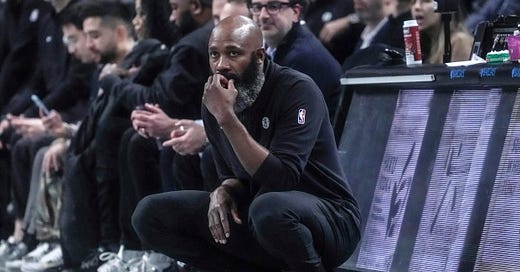Vaughn Hasn’t Found Answers As To Why Nets Continue To Allow Barrage Of Uncontested 3-Point Looks
Prior to the Nets’ 115-103 victory over Toronto on Tuesday night, NetsDaily.com reporter Lucas Kaplan elicited a curious response from Brooklyn Head Coach Jacque Vaughn when he was asked about all the wide open three-point shots his team’s defense had been surrendering, something I highlighted in a previous post ( (1) What’s Up With The Nets’ Shoddy Defense And Can It Be Fixed? (substack.com)). Kaplan’s own research showed that the Nets were overly generous on opponents’ above-the-break three-pointers, mostly from overhelping one pass away from the ballhandler.
“(The defensive scheme) is designed that way,” Vaughn replied. He went on to say that the focus is on limiting points in the paint (where Brooklyn does rank eighth in the league in that category) and how each team has certain shooters who are more likely to be accommodated when firing from deep than their top marksmen. But only at the end did Vaughn mention anything about contesting three-point shots, an effort at which his team continues to be miserable.
What made those remarks incredibly strange to me was that Vaughn always talks about how jacking up a high quantity of 3s is a key marker for evaluating his own club’s offensive performance. So, how can generating volumes of three-point looks be good, yet conceding them is also an element of the defensive game plan? It’s not like the math that shows the bonus of the three-point shot changes on each end.
In some respects, you can say the strategy had been working fine for the Nets. They were 9-8 against a generally difficult early-season schedule entering Thursday night’s very winnable home game versus Charlotte and were ninth in the league in three-point percentage defense at 35%.
However, Vaughn’s defensive principles (likely approved at higher levels in the organization’s collaborative culture) fails to account for two points: 1) Not all three-point looks are the same, and 2) If you give most NBA players enough wide open opportunities to make shots, at some point, they will start taking advantage of them.
And sometimes when those start to go down, the ensuing three-point avalanche can become awfully difficult to quell. That’s what happened on Thursday night, as the Hornets bit the Nets with an unconscious 21-for-36 (58.3%) performance from behind the three-point line to send Brooklyn to a brutal 129-128 defeat. According to NBA.com’s tracking, all but one of those attempts were deemed open looks (greater than four feet of space to the nearest Nets defender). The Hornets found over six feet of space on 23 of them, which is more than any team allows per game.
While the Nets’ effort in giving up 74 points during the first half to a bottom-10 offense like the Hornets was unacceptable, I actually thought their defense played a little tighter after intermission. It didn’t matter, because they had boosted the Hornets’ confidence so immensely by allowing more three-pointers (11) in 24 minutes than Charlotte had been averaging per game (10.8). It seemed everything the Hornets threw up at the rim in the second half went in, which was why their percentage actually improved by 1% over their first half rate. Miles Bridges hit one while falling out of bounds in the right corner and Terry Rozier, whom the Nets often could count on for a 3-for-12 outing, made 7-of-9 3s en route to a 37-point evening.
In response to that first half debacle, Vaughn said, “Some of those 3s they made, they made them because they were comfortable. So, when you give an NBA guy a little comfort who hasn’t made shots historically, then the confidence builds and you’re able to see the ball go through the hole, and we paid for that tonight.”
Hmm, was that an epiphany, or was he doubling down by saying that when the opponent’s shots fall, it’s his players’ fault; but when they miss, letting them hoist those attempts was always part of the grand scheme?
Sorry, but Vaughn can’t have it both ways. He and his analytics staff can draw conclusions from a host of stats in scouting reports in preparation for games, but the defensive goal always has to be minimizing points allowed per 100 possessions. This bad loss dropped Brooklyn to 21st in the league in defensive efficiency, but even that only tells part of the story. The Nets have allowed under the NBA median of about 113 points per 100 possessions just seven times in 18 games. They are 7-0 in those contests, and 2-9 when their defense hasn’t measured up to the league standard.
This despite boasting a host of above average individual defenders like center Nic Claxton and wings Mikal Bridges and Dorian Finney-Smith. Vaughn has even tried a multitude of pick-and-roll coverages (he abandoned the 2-3 zone that looked promising in Sunday’s victory over Chicago after two possessions that ended with Charlotte three-point field goals). We’re nearing the season’s quarter point, and Vaughn’s players still don’t seem to get how they’re supposed to be executing these schemes.
The Nets just lost a game where they took 14 more shots than their opponent with similar free throw and turnover numbers. They lost because their 134.4 defensive rating was their highest of the season. Because quality beat quantity.
The result was exactly what the Nets deserved.



